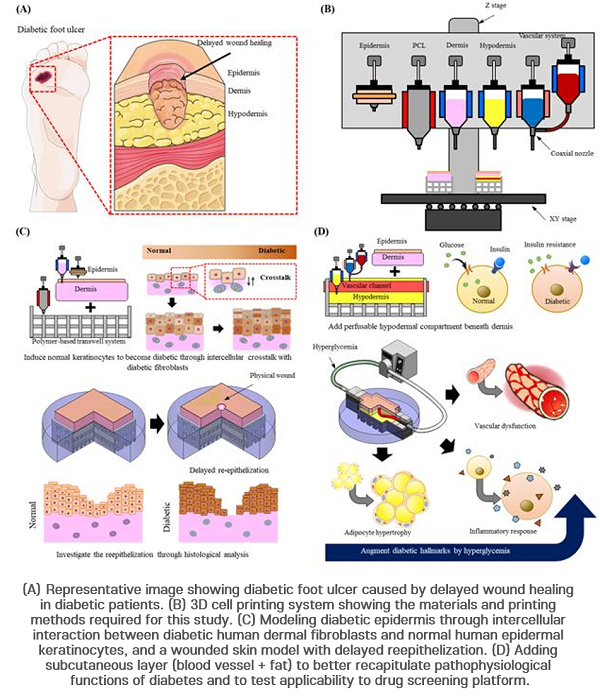A Korean research team from Pohang University of Science and Technology (POSTECH) and Pusan National University have 3D printed an in vitro artificial skin model to observe skin diseases suffered by diabetic patients.
According to the researchers, despite ongoing advances in producing artificial skin with 3D cell printing technology, a disease model displaying the pathological processes present in native skin has not yet been reported.
As such, the research team embarked upon modelling a 3D diseased skin tissue with the physiological processes that cause and are associated with type 2 diabetes using a 3D cell printing technique. The researchers also demonstrated the feasibility of their new disease model for drug development by applying test drugs.
“Through 3D cell printing, we can now observe skin diseases in vitro, without actually experiencing it,” said the researchers. “We anticipate it to be a way to replace animal models that have been conventionally used to observe skin disease.
“It is significant that its applicability as a disease model for new drug development has been proven.”
Skin problems associated with diabetes
According to the American Diabetes Association, skin health problems are often the first visible signs of diabetes. Type 2 diabetes can make existing skin problems worse and cause new issues, such as blisters, rashes, fungal infections, and itching.
This reaction typically happens when the body either does not respond normally to insulin or cannot produce enough insulin to maintain a normal blood sugar level. Long-term diabetes complications with hyperglycemia (high blood glucose) tend to be associated with poor blood circulation, which can impair cellular function and make self-healing difficult.
According to the researchers, diabetes-related skin diseases still have poorly effective cures. In their paper, they outline that previous studies mainly focused on the development of diabetic animal models to investigate the skin’s response and develop medications for wound healing, however ethical concerns around using animals and the possibility of inaccuracies due to the genetic differences between animals and humans limit this approach.
As such, the research team, led by Professor Don-Woo Cho and Minjun Ahn of POSTECH and Professor Byoung Soo Kim of Pusan National University, turned to 3D printing to engineer a human skin model to offer more accurate predictions of the behaviour of human skin cells.

3D printing artificial skin
3D cell printing is already being deployed to engineer vascularized skin layers such as the hypodermis, dermis, and epidermis in research projects around the world.
For their study, the researchers used a droplet-based cell 3D printing technique to fabricate diabetic human skin fibroblasts, cells that make up fibrous connective tissue, and keratinocytes, the primary type of cell found in the epidermis.
They then printed a diseased human skin model embedding these structures within the main skin layers (epidermis, dermis, hypodermis, and blood vessels) to create skin wounds that displayed the properties of type 2 diabetes.
The research team hypothesized that when normal keratinocytes interact with the dermal layer made of diabetic fibroblasts, they would differentiate into diabetic epidermis.
During their study, this hypothesis was proven when they observed slow wound-healing in the diabetic artificial skin model, a typical feature of diabetic skin. When a diabetic fat tissue layer containing blood vessels was added to the model, insulin resistance, adipocyte hypertrophy, pro-inflammatory response and vascular dysfunction, all of which are commonly observed in diabetes, were confirmed.
These findings validated the research team’s artificial skin model as a feasible tool to observe and model skin diseases related to type 2 diabetes, in order to provide further understanding of the behaviour of skin cells within diabetic patients.
To demonstrate the potential applications of their engineered diabetic skin in dermatological studies and for drug testing, the researchers applied test drugs to the model’s vascular channels over a period of three days. They then observed the functional restorability of the epidermis and the reduced inflammatory response of the artificial skin.
Going forwards, the team anticipates their artificial skin model could help pave the way to replacing the use of animals to observe and test skin diseases and eventually provide a new disease model for drug development.
Further information on the study can be found in the paper titled: “Engineering of diseased human skin equivalent using 3D cell printing for representing pathophysiological hallmarks of type 2 diabetes in vitro” published in the Biomaterials journal. The study is co-authored by B. Kim, M. Ahn, W. Cho, G. Gao, J. Jang, and D. Cho.
Subscribe to the 3D Printing Industry newsletter for the latest news in additive manufacturing. You can also stay connected by following us on Twitter and liking us on Facebook.
Looking for a career in additive manufacturing? Visit 3D Printing Jobs for a selection of roles in the industry.
Featured image shows how 3D cell printing was used during the study to fabricate the artificial diseased skin model. Image via POSTECH.



